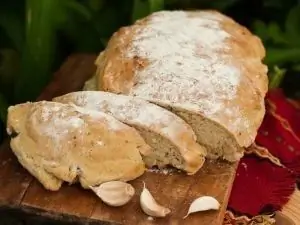2025 Author: Jasmine Walkman | [email protected]. Last modified: 2025-01-23 10:18
The traditional Bulgarian cuisine offers a huge variety of dishes for every taste and every pocket. Each house has its own recipe book with hundreds of culinary temptations. The culinary temptations, which are prepared in some of the regions of the country, deserve special attention. Even the name of some of the typical regional specialties sounds magical.
Just when a person hears a chomlek, kapama or babek, he immediately remembers the grandmother's kitchen in the village. Can the dishes from our childhood have the same magical charge and taste, if we prepare them now in our modern kitchen. Here are five extremely tasty traditional Bulgarian dishes that modern hosts rarely prepare.
Onion stew
This extremely fragrant and filling soup is typical for almost all of Bulgaria. The recipe differs slightly in different parts of the country. Whichever one you choose, you can be sure that onion soup is a delight for the senses. This simple dish has a pleasant and mild taste, quickly satisfies hunger. The end of winter is the right time to prepare it, because you can easily find arpadzhik (small onions) on the market, as well as ordinary old onions. In some regions it also adds leeks. The classic recipe for this dish is:

1. Take about 500 grams of old onions and about 200 grams of arpadzhik. Optionally, you can add a stalk of leek. Cut them into small pieces and stew them until soft with two or three spoons of fat of your choice.
2. Add about 800 mg to the stewed onion. Hot water. Some housewives choose to replace water with vegetable broth, but if you really want to enjoy a fragrant onion stew, do not add broth.
3. Allow the resulting mixture to boil over medium heat for about 10-15 minutes. Remove from the heat and add a mixture of two tablespoons of flour and two tablespoons of tomato paste, lightly beaten in lukewarm water.
4. Return to the hob and stir. Cook until it starts to thicken. Add salt, pepper and bay leaf.
To enrich the taste of the stew prepared in this way, you can pre-bake the onion in the oven until browned. Other hosts add chopped carrots and mustard, and when served sprinkle with parsley. Fans of experiments can taste this traditional Bulgarian dish additionally with prunes.

Stuffed dried peppers with ripe beans
Traditionally, this dish is present on our table on Christmas Eve. Then everyone enjoys the aromatic spices and rich taste. There is no reason for him to be absent from our table during the other winter months. In many of the smaller villages, this remains the preferred way to stuff peppers, unlike larger cities, where the hosts traditionally stuff them with minced meat. The preparation of this delicacy is relatively easy, the secret of the unique taste is the combination of spices.
1. Wash 10-12 dried red peppers and soak them in hot water to sauté and soften.
2. Boil about 400-500 g of old beans until fully cooked by adding a teaspoon of mint and a teaspoon of chopped savory to the water. The density should be like a thick soup.
3. Add a little salt and paprika to taste. Drain the mixture slightly prepared and fill the peppers with it.
4. Pour the drained sauce over the stuffed peppers and bake them in a slow oven.
If you are willing to experiment, you can add finely chopped pickles and chopped walnuts to cooked beans. The result is guaranteed to exceed your expectations.

Kachamak
This dish is extremely tasty and easy to prepare. Many of us as children often ate breakfast or dinner with porridge. Many memories are associated with the bowl of fragrant porridge, generously sprinkled with cheese, melted butter and a little red pepper. Or maybe you preferred it cooked with greaves and bacon. Some even make it in the form of a cake. Making porridge is easy, fast and not very time consuming.
Most of the stores offer ready-made mixtures for the preparation of this delicacy. If you follow the instructions on the package, your result is guaranteed. At home, porridge is prepared by pouring a very thin stream of cornmeal into boiling salted water and stirring constantly. And a culinary tip from Grandma's closet - if you don't want to get some yellow, sticky "something" instead of porridge, bake the cornmeal in a moderate oven for a few minutes. Garnish as desired and consume with pleasure.
Nettle porridge

We will not bore you with a long lecture on the beneficial properties of nettle. In the traditional Bulgarian cuisine there are many different ways to prepare it. Whether you choose to please your loved ones with plain nettle soup with rice or nettle porridge, it does not matter. Everyone will like this Bulgarian dish. Traditional nettle soup is easy and quick to prepare.
1. Stew a medium-sized onion in one or two tablespoons of fat of your choice. When the onion softens, add one chopped carrot.
2. Pour hot water or vegetable broth. Let it cook on a medium heat for 10 minutes.
3. Add the pre-washed and chopped nettles to the boiling mixture. Add salt and paprika to taste.
4. When the nettle is scalded, remove it with a slotted spoon and chop it. At this time, you can add a handful of rice to the broth.

5. Return the nettle to the pan and cook until the rice is ready.
6. You can thicken the dish with a spoonful of flour lightly diluted in lukewarm water.
7. Add a build of yolk and yogurt.
Try adding walnuts, olive oil and garlic to the dish prepared in this way.
Chickpea bread
The preparation of chickpea bread is typical mainly for the southernmost parts of the country. The secret of this fragrant bread is in the chickpea leaven. In a simple ceramic bowl, mix crushed chickpeas, a little water and a piece of rye bread. The mixture thus prepared is covered and left warm so that natural fermentation processes can begin. When this natural yeast is ready, knead a pie of equal parts wheat and chickpea flour.
Recommended:
Classic Dishes With Rabbit

Surprise your loved ones with delicious rabbit dishes according to classic recipes known around the world. One of these recipes is rabbit spindle . Necessary products : 1 kg rabbit fillet, salt, pepper, 1 onion, 100 g dried tomatoes in olive oil, 1 sprig of rosemary, 1 tbsp vegetable broth, 2 tbsp olive oil, 1 tbsp rose dry wine, 6 pieces of bacon, 1 bunch parsley.
Three Forgotten Recipes For Patchouli

Although many consider pacha to be a typical soup for the common people, it is actually very nutritious and does not require much effort to prepare. Not suitable for the hottest months, but there is nothing better than eating the beginning with a glass of red wine when it gets cold outside.
Everyone Has Forgotten About These Vegetable Juices, And They Are The Most Useful

Vegetable juices are very useful. There are some that we don't even think we can make. And they are just as useful and delicious as our acquaintances. To make fresh vegetable juices more useful, we can mix them with herbs. See which are the vegetable juices that we undeservedly neglect.
Forgotten Sweets That Are Always A Hit

Nowadays, confectioneries can offer us a wide variety of desserts, with chocolate muffins and blueberry cheesecake, Italian Tiramisu or French souffle standing out in the foreground. Yes, they are definitely very tasty, but there are also cakes that do not taste like them in any way, we just forgot about them.
Four Classic Dishes That You Cook Wrong

An interpretation of the famous chef Jamie Oliver on the theme of "paella", which violates the traditions of Spanish cuisine, caused a furor and triggered a wave of comments, most of which were negative. Experts in this field have decided to remind us of some of the most commonly prepared and in fact well known to most people foods, but somehow over time we have changed more or less.

